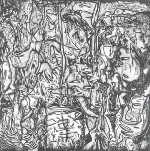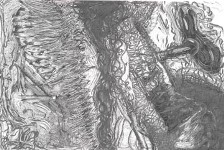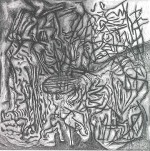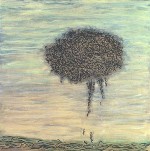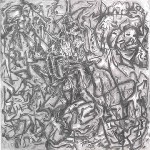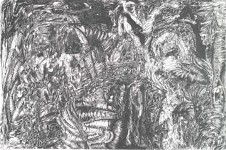Winter 2000, Volume 17.2
Art
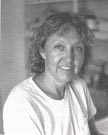
Bonnie Sucec
Learning to See
Bonnie Sucec's studio is above a bicycle shop in Salt Lake City. Her art can be found in collections in Utah and around the world. She has a Master of Fine Arts in painting and drawing from the University of Utah. A frequent participant in Artists in the Schools, she has also taught and shared her enthusiasm for art in nursing homes, prisons, and homeless shelters.
[Image not Available]
"The Sea" 30" x 44"
I think art makes everybody respond in certain ways. What we see makes us feel. And we want to see things we haven't seen before.
I'm not a confrontive artist, that's why I paint abstractions. Figures can be very powerful and confrontational, because you see the image as a person or something that you have to deal with. I'm interested in figures, but I'm more into abstract feelings and sensations.
o o o
We have to do a lot more art of all kinds in the schools. Little kids are so good at art. In the early grades they have so much confidence. Then someone, a teacher or parent, starts encouraging them to draw a certain way until they feel that they're not competent, and that's too bad.
It's important to be creative, that's the important part. But you kill creativity if you're forced to draw a certain way or with a certain look or a certain color in the lines.
I always want to touch art. I understand why galleries can't let people do it—because of the oil on our hands. But every painting feels different.
Some of my work is carved into wood with a tool called a dremel. Then I paint over the carved wood. It's a time consuming process. I use veneered plywood, and I don't start with a specific drawing. I let the dremel take me. I put the plywood on a table and carve slowly. If I hit a knot in the plywood, the dremel jerks, and I let those jerks guide me in making the lines. To me that's a more interesting work of art.
How do I begin a painting? The way I'm working now, I usually put some shapes or colors down on the paper and see where that takes me. I don't make preliminary sketches, I put them right on the paper or canvas. And frequently I'll start with things that I know are hard for me—colors that are difficult for me to deal with, maybe yellows or reds or oranges. I think it's difficult to mix yellow in with the other colors and make it look right. So that's where I start.
So I put some shapes on the paper, and then I'll look at what red does, or maybe I'll put some little marks or use a sponge, and then I'll see what's happened, how much white paper's left. And then I might say, this is kind of interesting over here—this white shape where the red didn't go, and I'll develop it into something, like a ball or a shape or something I haven't done before. I don't like to get into the same trap. I don't want to be formulaic. So I'll try to figure out something with that white piece of paper, with different colors or some lines in it, and then I'll stand back and think, maybe if I took that underneath and then brought it over here…and I'll do it, and just keep working until I've finished.
I'm very interested in word play. I'll clip words from the New York Times and keep them in this box. I can go through the New York Times with an Exacto knife and cut out whole piles of fun words. It doesn't have to be the Times, but they're more clever in their writing. Then when I need a title for one of my pictures, I'll reach in and grab something, and tape it to the back of the painting. "Big Thunder, Little Rain" came that way. I always name a painting after it's done. I never think of a title before hand.
Computers are handy, but they don't affect me as a painter. As the world is becoming more global through electronics, I think you need a hands-on painter, artist or writer. Art is very important to our lives. I have a computer at home, but I use it mainly for writing grants or e-mailing.
o o o
The best feedback you get is when somebody you admire says something about a piece of art, positive or negative. I feel bad when it's negative, but I understand, and I, too, usually feel it's bad. You know it's bad when it's bad.
o o o
I love to do art, and I always have. I'm always thinking that the next one will be better, and so I keep working. I get inspired by seeing art, and that's one of the things I'm going to look for when I go to Spain. I'm going to Barcelona and Madrid to the galleries and to see the architecture.
I paint burned matches, because I like the shape—the little patterns, how they fit together. They are quite suggestive; you light a match and "phhht" you see the flame. I've always been interested in matches. I didn't play with them as a child, but I did collect match books—they had the name of restaurants and pictures on the cover. My parents would bring them home to me, and I had a box of them.
Art is hard work, but I love it. Art adds so much value to our lives. We learn from art, we learn how to see things. Eighty percent of what we know comes from what we see—how things are put together.

